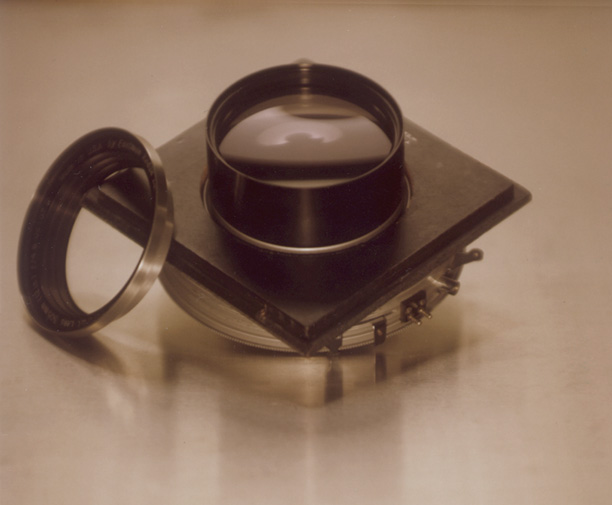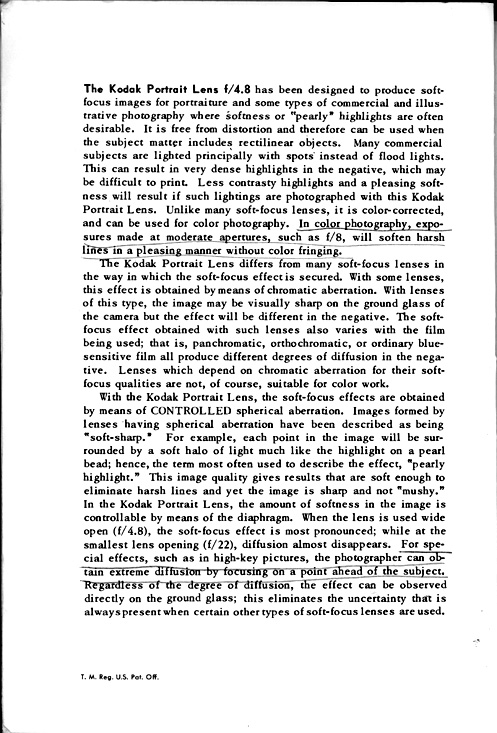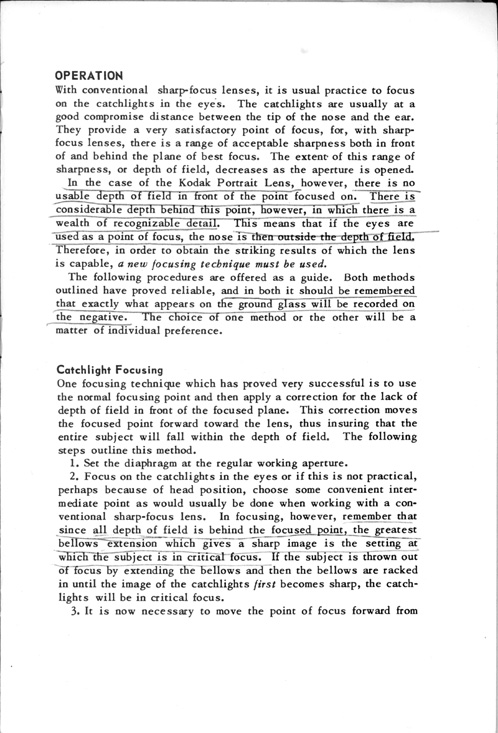The Kodak 305mm Portrait lens showed up while I was waiting for the right face
I'm going to do 2 more shots for my tribute to 'Black Mask' mag, and I'm waiting for the right face, a feminine face, a face that exudes mystery to complete the last two shots of that gallery. I may have a long wait, but I'm not in that much of a hurry, because it's never helped to be in a hurry.
Surfing around for the various portrait/soft focus lenses that had come up for sale while I was waiting was my first mistake. My second mistake was talking myself into bookmarking the auction of the Kodak Portrait lens that I eventually acquired, and my third mistake was finding out how much these classic lenses have gone down in price lately. I'd promised myself no more $1,000-$2,000 lenses, and in my twisted logic, and in the grip of an 'irresistable impule', I rationalized that I was somehow not betraying my promise to myself by bidding out under $500.00 for the Kodak.
It is after all, the Kodak version of the Pinkham & Smith Semi-Achromatic, with an Ilex #5 Universal shutter which used to be worth $300.00 all by its lonesome.
I expected this to happen, because the realization is finally sinking in that these lenses are harder to use than other lenses, and the 'honeymoon' is ending w/many realizing that these lenses want you to do more for them than what they can do for you. Only after putting in a tremendous amount of work and sweat into these lenses, will they start giving you a 'glimmer' of what you can imagine they can do.
Some will never wring the imagery from these lenses that they expected, and it might end up a good thing, ultimately, nudging folks into another direction where they can flourish, and lowering the prices for those who want to keep on trying to 'hang' w/these 'beasts'.
This lens came w/it's original box which is quite fancy, and best of all, it comes w/an original manual, w/the manuals slant on the Kodak portrait lens and how to focus it. The manual sheds further light on how folks felt 'back in the day' about the concept of how to focus a portrait navigating between the ears, the eyes, and the nose, which is a neverending conumdrum for the portaitist. Most importantly, the manual talks about the concept of sharp inside soft as opposed to 'mush', and again, it will never happen, but I'm so sorry that the creators of these lenses will never get to see how some folks in their future, got these lenses to live again by way of what's being produce today.
Take care





![[Your Site Name] [Your Site Name]](/storage/WideOpen%203%20tst2.jpg)

Reader Comments (8)
'tis a lovely device Jonathan, lovely. I've been waiting for one to come along and fall in my lap but so far one has not. Anxious to see some results.
I've been playing with a Rochester Optical Co. No. 3 landscape meniscus. 9 1/2". If I get something nice I'll stop by here with it.
Hi J
It's incredible how you come up w/these landscape meniscii, I can never find them, but I'm pretty much satisfied w/this lens so I've stopped looking for landscape glass.
The whole deal for the Kodak is sweeter because of the manual, and its discussion of the lens and focusing as if they were talking about it this, this very minute.
From everything I've seen written about these lenses, as of 50-100+ yrs. ago, nobody liked 'mush' anymore than we do. Just confirms that these lenses were given a 'bad rap' because of shots that were 'butchered' involving this type of glass.
I was prepared to be disappointed by the Kodak portrait since I hadn't liked the coated version of the Verito, the Veritar, which I got rid of. I thought the coated did something that took away from the look of the Verito.
I'm having them take off the B&J board and mount it on a 110 Canham I ground down to fit my 45 Toyo and my 8x10 adaptor. The lens fits my other Ilex #5(they're exactly the same shutter, w/same front/back threads[the front nameplate is a screw off series IX apaptor and comes off). Thus if you find the lens minus the shutter get it, if you're of a mind to get the shutter later.
I've mounted the lens on my 4x5 & 8x10 Toyos, and the look is fabulous, the 'Lumenized' coating whatever it is, is just right, and the lens has 'sparkle' and 'sheen' to the max. I'm now glad I got it. It has a 'sizzle' and 'pop' to it that's hard to describe, but definitely different from both the Visual Quality and the Semi-Achromatics, hell........actually, IT IS a Semi-Achromatic w/a coating.
The glass is thick and as curved as on the Pinkhams. If you're looking for one, I'd say you'd like the 'look'.
Take care
I've had a chance to look through my Toyos w/the 305mm Kodak Portrait in a room w/subdued lighting at a clear lightbulb being hit w/specular highlights from the window. This is kind of the set-up I use to look at just what one of these lenses does as opposed to the others. I think I can verbalize some of the differences the Kodak brings to the table as opposed to the Pinkhams Achromatics/Gundlach Achromatic Meniscus et al.
Looking at a clear lightbulb being hit w/specular highlights coming through the window in a fairly dark room/subdued lighting, the Pinkham Semi-Achromatic Ser I, and Semi-Achromatic Doublet Ser III, will present the spec. highlights that are actually on the bulb as blown out white, with also a fairly wide band of glow/flare around the outside of the bulb.
Your various soft focus/portrait lenses will blow the spec highlights out to a different intensity, and present varying widths and the band of flare around the object will be almost impenetrable(where you can't see through it, or very faint). Point the Pinkham & Smith Semi-Achromatic Doublet Ser III at an object with specular highlights intense enough, and you can blow out the highlights and flare out the whole frame, it is the champ I believe for flare.
Looking at what the 305 Kodak Portrait does in the above set-up I can only think of 'Pearlescence'(pearlescent - having a play of lustrous rainbow colors; "an iridescent oil slick"; "nacreous (or pearlescent) clouds looking like mother-of-pearl"; "a milky opalescent (or opaline) luster").
The Kodak w/its 'Lumenized' coating doesn't present a pronouced flare(it's faint in this lighting set up), but does give a 'Pearlescent' sheen to the specular highlights actually on the bulb. Where the other lenses just plain blow out the spec. highlights on the bulb, the Kodak(I'm guessing because of the coating) tones this down.
The above discussion ties into a request by email I just got from somebody which asks 'what do you mean a learning curve for these lenses, what do you mean in terms of specifics?'..........So I'll be brief as I can and touch on what I've picked up from messing around w/these things.
You can play up or you can make the flare disappear from the specular highlights hitting an object by using a light/dark backround or by using more/less light on the background. Go to www.imageandartifact.bz then galleries, go 2 the 'Pellucere' gallery, and click 'Goggles'. The flare around the outside tips of the goggles in pretty intense, I set up a faint background light which I positioned just inside the tips of the goggles and then tended to mute the flare except for the tips. I did this intentionally.
As you go from direct to bouncing your source illumination off a wall/reflector, these lenses began to handle specular highlights/flare in a more pleasurable way(whatever that means). I also knock down the light by not compensating for bellows factors while leaving the aperture wide open.
These lenses should not be called soft focus lenses, They ought to be called selective focus lenses, cuz you don't do nothing wideopen w/o a strong consideration to selective and that has as much to do w/more than whatever the lens makes soft. This ties into how these lenses focus, the P&S Semi-Achromatic Double Ser III focuses forward, some of these lenses focus backward, and you can use the focusing characteristics as much as the soft focus aspect to do some interesting things w/these lenses.
Go back to the above names gallery on my website(Pellucere) and click on '3 Glasses', I got this effect by focusing on the front rim of the glasses knowing the lens focuses forward, w/everything BEHIND the best plane of focus going IMMEDIATELY OUT, and I mean IMMEDIATE. Right behind the rim to the back everything goes out to such a drastic degree, that this is the only shot I've shot like this. If there's another lens in the Galaxy that can produce this effect, I'm standing in line to get a look.
The learning curve is in figuring out how to manipulate lighting and selective focus at wideopen to utilize what these lenses have. I had to continulally force myself to keep from closing down the aperture to solve my initial problems w/not getting what I knew were benefits from shooting wideopen.
The gifts from these lenses are also their curse.
In one lighting set-up, the Pinkham & Smith SA Ser III makes everything look terrible, and after spending 6 months restoring this lens, and quite a bit of money, the first thing I did when I got possession of the lens, was put it on my Toyo and point it through a window on a very bright day. I couldn't see ANYTHING, EXCEPT WHITE. This experience was depressing, but I had to work from there, and I think anyone can come up w/some interesting things w/these lenses if you stick w/it.
Take care
One point of clarification...............I judge these lenses and their soft focus characteristic by looking at a clear(it should be clear for this) light bulb being lit by light coming through a window in a dark room because w/the bulb being transparent, there's nothing on the bulb except the specular highlights coming form the window and the flare around the highlights.
Set the bulb in the right position and you see through the bulb to nothing but darkness, except for the specular hights and flare hitting, and you can't be fooled by other tones/textures which might give a false sense of what you lens is doing.
Take care
I have lusted after this lens for so long, it's the only softfocus lens i have been intrested. Becouse it seems to be just perfect, it's an ektar after all! I have found only few images made with this lens from the internet.. so i'm really wating to see what you can do with it, and to see what IT can do!
Hi Usko
I appreciate your comment, it's good to hear from you. I'm going to try to incorporate some shots from this lens on my 'Back Mask' project if at all possible.
On first inspection, this lens seems to be the equal of the earlier Pinkhams.
Incidently, if you'd like to become a member of this site, by all means email me at lifestories at earthlink dot net and I'll sign you up w/a login and password.
Take care Usko
I have a Kodak 305 Portrait lens and have a few examples on my flikr page. I have the photos set for family and friends so you'll have to request to be a friend, I think.
http://www.flickr.com/photos/20127080@N00/
Thanks for sharing so beautiful information. I had also a kodak digital camera and i wanted to change the focus lens. where i can get the lens in delhi.